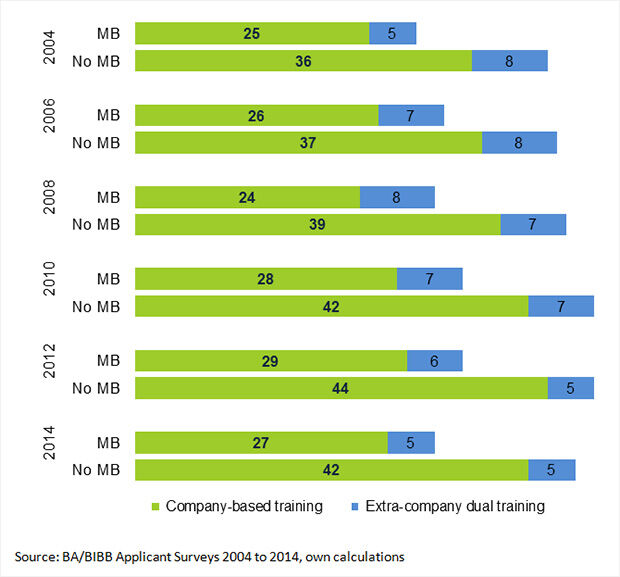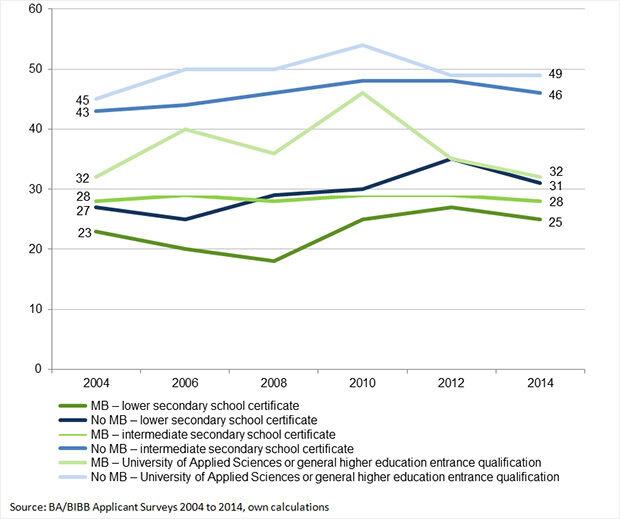Young people from a migrant background – chances on the training market
Ursula Beicht
The training market situation has significantly improved for young people over recent years. Has this led to better opportunities for young migrants to find a training place? The present article looks into this question via a consideration of the training place applicants registered with the Bundesagentur für Arbeit (BA) [Federal Employment Agency] for the period from 2004 to 2014.
Group of persons forming the object of investigation
In the 2014 placement year, a good quarter of the training place applicants registered with the BA (just under 560,000 in total) were from a migrant background (cf. BEICHT/GEI 2015). By definition, all persons who are registered as applicants are in possession of the necessary apprenticeship entry maturity. Applicants from a migrant background were either born abroad, hold foreign citizenship or else learned a language other than German as their mother tongue. Around two thirds were born in Germany, and about the same number also hold German nationality. Almost two thirds learned German as a (second) native language. The vast majority of young migrants has gone through the German school system, whereby they are more likely than applicants not from a migrant background to have achieved only the lower secondary school leaving certificate or no school leaving certificate.
On a two-year cycle, BIBB works in conjunction with the BA to carry out a survey of registered applicants in the placement year regarding their search for training and their destination. These representative BA/BIBB applicant surveys are conducted in written postal form at the end of the calendar year. Attention needs to be drawn to the fact that registration with the BA is voluntary. For this reason, young people who find a training place without being registered are not recorded as applicants. In 2014, this applied to just under one third of all young people interested in entering training.
Low level of training search success
Although registered applicants from a migrant background frequently make even greater endeavours to obtain a training place than their counterparts not from a migrant background (cf. BEICHT/GEI 2015), they are significantly less likely to be successful in their training search. In the 2014 placement year, for example, only 27 percent of young migrants progressed to company-based training, whereas the corresponding figure for young people not from a migrant background was 42 percent. Despite the improvement in the training market situation in overall terms, there has scarcely been any rise in the progression rate to company-based training for applicants from a migrant background over the past ten years (cf. Figure 1). By way of contrast, the progression rate for young people not from a migrant background has increased markedly. This has reinforced the differences between the two groups of applicants.
Alongside company-based training, disadvantaged young people have access to a limited range of extra-company dual vocational education and training, which is predominantly publicly financed. This, however, makes very little impact in terms of compensating for the worse chances experienced by young migrants in company-based training.
Figure 1: Progression of applicants from and not from a migrant background (MB) to company-based and extra-company dual VET from 2004 to 2014

A long way away from equality of opportunity
The school leaving qualification achieved is significant in determining success in the search for company-based training. The higher the qualification, the better the chances normally are. However, even if the same school qualification is obtained, applicants from a migrant background are less likely to be successful than those not from a migrant background. As Figure 2 shows, the progression rates between the two groups have always differed significantly in the case of a lower secondary school leaving certificate. The difference is four percentage points in 2004 and six percentage points in 2014. The variations are even greater in the case of an intermediate secondary school leaving certificate (a difference of 15 percentage points in 2004 which is rising as high as 18 percentage points in 2014). The chances of migrants in possession of the intermediate secondary school leaving certificate are now only marginally better than those from a migrant background who hold a lower secondary school leaving certificate, and compared to persons with a lower secondary school leaving certificate and not from a migrant background, the former group is even at a disadvantage.
Figure 2: Progression of applicants from and not from a migrant background (MB) to company-based training from 2004 to 2014 by school qualifications

Persons in possession of a higher education entrance qualification who are from a migrant background are also much less likely to progress to company-based training than those not from a migrant background. After relatively strong fluctuations over the last ten years, the progression rates (in both groups of applicants) are now scarcely higher than for those in possession of the intermediate secondary school leaving certificate. Increasing orientation to higher education probably plays a major role in this regard. Nevertheless, it is noticeable that, since 2012, the progression rate of persons in possession of a higher education entrance qualification who are from a migrant background has been virtually the same as that of persons who hold a lower secondary school leaving certificate and are not from a migrant background.
Alongside the school leaving qualification, there are also further factors which exert an influence on successful transition (cf. EBERHARD 2012). Young people’s social origin, their school qualification and the situation on the regional training market are of major significance within the process. Multivariate analyses, in which the various influencing factors are considered at the same time, nevertheless make it clear that the disadvantages experienced by young migrants at the transition to company-based training cannot be solely explained by these factors (cf. the summary provided in BEICHT 2015). The differing career wishes of applicants from and not from a migrant background are also not decisive in this regard (cf. BEICHT/WALDEN 2015). The conclusion of all this is that young migrants are significantly less likely than young people not from a migrant background to obtain a company-based training place even if the same conditions apply.
Conclusion – companies need to have fewer reservations
Many companies are now complaining of major difficulties in filling their training places. At the same time, young people from a migrant background who are considered to be in possession of apprenticeship entry maturity very frequently fail to find a training place. The supposition is that company selection procedures produce disadvantages for young migrants, and this is indeed something which existing studies indicate (cf. the summary provided in BEICHT 2015). Companies do not seem to accord the same degree of recognition to the school certificates of young migrants as they do to those of young people not from a migrant background.
This is also a particular concern with regard to the many young people who have fled to Germany as refugees in recent times and whose integration can only succeed via well-founded vocational training. The training of such persons poses an especially large challenge. In order to improve training opportunities for all young people from a migrant background, it seems indispensable to raise the level of acceptance they receive in the companies providing training.
Literature
BEICHT, U.: Berufliche Orientierung junger Menschen mit Migrationshintergrund und ihre Erfolgschancen beim Übergang in betriebliche Berufsausbildung. Überblick über Ergebnisse quantitativer Forschung der letzten zehn Jahre in Deutschland sowie vergleichende Analysen auf Basis der BIBB-Übergangsstudien und der BA/BIBB-Bewerberbefragungen [Vocational orientation of young people from a migrant background and their chances of success at the transition to company-based training. Summary of the results of quantitative research from the last ten years and of comparative analyses conducted on the basis of the BIBB Transitional Studies and the Applicant Survey carried out by the BA and BIBB].Wissenschaftliches Diskussionspapier [Academic Research Discussion Paper] 163 Bonn 2015 – URL: https://www.bibb.de/veroeffentlichungen/de/publication/show/id/7716 (retrieved: 23.05.2016)
BEICHT, U.; GEI, J.: Ausbildungschancen junger Migrantinnen und Migranten unterschiedlicher Herkunftsregionen. Aktuelle Situation 2014 und Entwicklung seit 2010 - Ergebnisse der BA/BIBB-Bewerberbefragungen [Training opportunities for young migrants from different regional origins. Current situation 2014 and development since 2010 – Results of the BA/BIBB Applicant Survey], BIBB Report 3/2015. Bonn 2015 – URL: https://www.bibb.de/veroeffentlichungen/en/publication/show/id/7834 (retrieved: 23.05.2016)
BEICHT, U.; WALDEN, G.: Unterschiedliche Berufsinteressen als Einflussfaktor für die Einmündungschancen in betriebliche Ausbildung? Ein Vergleich zwischen männlichen und weiblichen Jugendlichen mit und ohne Migrationshintergrund [Different occupational interests as an influencing factor for chances of progression to company-based training. A comparison of young males and females from and not from a migrant background]. In: Journal for Labour Market Research 48 (2015) 4, pp. 325-346
EBERHARD, V.: Der Übergang von der Schule in die Berufsausbildung. Ein ressourcentheoretisches Modell zur Erklärung der Übergangschancen von Ausbildungsstellenbewerbern [Transition from school to vocational education and training. A theoretical resources-based model to explain the transition chances of training place applicants]. Bielefeld 2012
URSULA BEICHT
Staff member in the “Vocational Training Supply and Demand/Training Participation” Division at BIBB
Translation from the German original (published in BWP 4/2016): Martin Kelsey, Global Sprach Team, Berlin